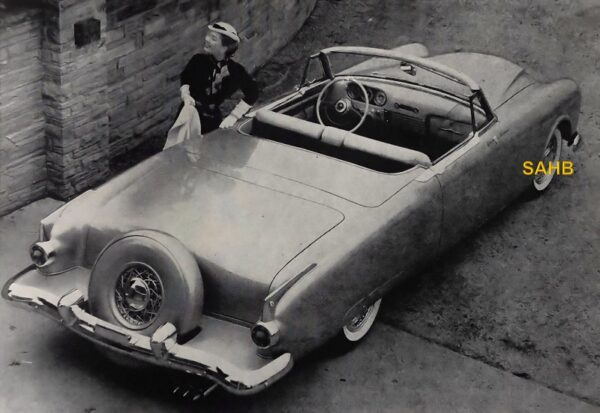
The 1952 New York International Motor Sports Show was the ideal venue for the launch of this concept car by Packard. The reaction at the show can be summed up in one word: “Wow!”
The Packard Pan American was conceived as a moderate-performance two-seater by Hugh Ferry, president of Packard. It was designed by Richard Arbib and built by Henney Motor Company, whose ‘day job’ was building custom hearse and ambulance bodies on Packard chassis. Based on the 1951 Series 250 Packard convertible, the Pan American had been chopped (the windscreen), sectioned (a strip of body removed and lowered) and channelled (the body dropped lower on the chassis). It was painted in a beautiful ‘Green-Gold’ metallic. Americans were crying out for a modern car that was long, sporty, luxurious, and low – and this was it.
Packard’s intention was to create far more than a concept car. The Pan American signalled that Packard was assertively reclaiming its position in the luxury car market. The car won a top award at the New York Show and went on to win again at the Petersen Motorama auto show in Los Angeles. It was featured in magazines and newspapers worldwide. This car was for a long time thought to be a one-off – but six were built. Due to the huge popularity and interest generated by the first car, Packard agreed to have five more Pan Americans built at Henney Motor Company.
But Packard management struggled to think of a viable market for a convertible projected to cost at least $18,000 at a time when the top-line Lincoln Capri six-passenger convertible cost $3,665 and the eight-seater Cadillac Series 75 Fleetwood $5,643. Even Packard’s Patrician 400, their most expensive production model, was only $3,767.
The first car underwent many changes, the first when it was featured in the world-famous Pasadena Rose Parade. The hand-built wheels looked wonderful but were not very roadworthy. The car was reported to be “all over the road” with shakes and shimmies. Factory Packard wire wheels were fitted to correct the problem. But Packard could not leave well alone. Every time Ed Macauley, Packard’s head of styling, got a new idea, he took it out on whatever car he was driving. He got his hands on the Pan American, and today this car is painted white with the grille changed, wings changed, interior changed, and 1955 Packard cathedral taillights grafted on.
The other five cars were mercifully not changed as much. Three of them now reside in collections, one at least having been restored to magnificent condition and looking as far as possible like the original Pan American. The fate of the final two is still shrouded in mystery.
The project was not totally in vain. The Pan American inspired Packard’s 1953 Caribbean production car.
Image courtesy of The Richard Roberts Archive: www.richardrobertsarchive.org.uk







Leave a Comment